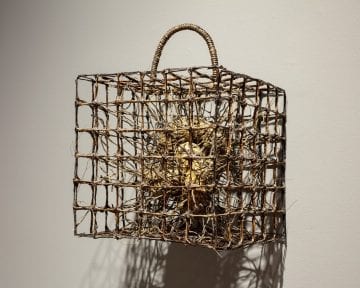Ogden Museum continues Curated Conversations, our popular series of intimate talks, now online! Curated Conversations bring curators and artists together to discuss art, exchange ideas and explore exhibitions. This Curated Conversation features Entwined artist, Ed Williford, and Curator of the Collection, Bradley Sumrall.
This work by Ed Williford is up for bid in the O What a Night! Silent Auction, taking place Oct. 12-18! Mark your calendars!

Ed Williford, Knot in Box (With Handle), 2015, 12 x 12 x 12, Wire, paper, twine, glue, Courtesy of the artist
CURATED CONVERSATION:
ABOUT ED WILLIFORD
Born in 1963, Ed Williford was raised in Jackson, Mississippi, and currently lives and works in Brookhaven, Mississippi. After studying art, philosophy and architecture at Mississippi State University and Ole Miss, Williford moved to a rural farmhouse in Magnolia, Mississippi in his mid-thirties. On the farm, Williford created an existence for himself that was filled with open time, an existence that allowed him to begin a period of self-examination through art.
Williford creates abstract sculptures from non-traditional everyday materials. “I find my materials in thrift stores and hardware stores,” he says. It is that alchemy of transforming common materials into mysterious and uncommon objects that drives his work. There exists in each object a tension between industrial mediums and organic forms, between the common and the rarified, between reality and fantasy. His palette is monotone, mainly derived from oxidation and coffee. Much of his fabric is sourced from thrift-store drapes. Other materials include Elmer’s glue, tape, wire, chicken feed sacks and loofah.
Williford arrived at his practice intuitively, following his own interest in the everyday materials in his life. It shares many of the hallmarks of the Arte Povera movement in 1960s Italy. Through the use of simple materials and forms, the everyday becomes meaningful and the hierarchies of “art” and common objects are broken down. Ultimately, though, the work of Ed Williford is the expression of one man’s exploration of the material culture around him. He is following his imagination and his hands, finding his place in the world through the ritual of repetitive handwork – wrapping, binding and twisting the common towards something transcendent.
ABOUT ENTWINED: RITUAL WRAPPING AND BINDING IN CONTEMPORARY SOUTHERN ART
This exhibition explores how wrapping and binding are used in the work of eleven contemporary artists from the American South. It also explores the motivations, inspirations, and meaning behind the acts of wrapping and binding objects through the varied perspectives of this diverse group.
The act of wrapping objects and binding things together is as ancient as mankind itself. Weaving is at least 12,000 years old (recent discoveries suggest possibly 27,000), and the world’s oldest sewing needle (made of bird bone possibly by Denisovans) dates back to approximately 50,000 years ago. While it is an ancient and very human act, perhaps the inspiration arose from observing nature. Spiders bind filaments together to form a web, and wrap their prey in silk. Vines wrap and cling for support and movement. Birds build nests and bagworms build homes through binding objects together. Each and every one of us begins life bound within the womb, one life entwined with another. Perhaps that is part of the primal urge to wrap objects: to protect them, hide them, contain them. Wrapping can be a preservative endeavor, like the mummy’s quest for immortality. It can be a violent act, like the coil of the snake or the chains of human bondage. It can be an act of solidarity and devotion, as with the hand-fasting rituals of marriage. Every wrapped package or bound bundle contains a secret – a hidden thing, the unknown – and activates the very human emotions of curiosity or fear.
From Native American sacred medicine bundles to the Jewish laying of tefillin, wrapping and binding have been used as a symbolic device by humans throughout history. Both the ritual act and the act of creating art are ways of putting concrete reality to abstract ideas. Drawing inspiration from the traditions of various cultures – Haitian Voudou, Appalachian broom-making, Calabrian silk production, Peruvian rope coiling, Congo Nkisi – the contemporary artists in this exhibition engage wrapping and binding as both symbolic aesthetic device, and often as a ritual practice within their work.
Each artist in this exhibition approaches the simple acts of wrapping and binding from a unique perspective. Some are involved in the haptic absorption of repetitive handwork – a sort of ritual meditation on texture and rhythm. Others are exploring the symbolic power of the physical act – weaving narratives through form, image and materials. This exhibition contains a feast of texture and a vast range of materials – clay, fabric, rope, egg tempera, driftwood, loofah, antler, bone, wire, coffee, ashes, teeth, yarn, wool, chalk and a plethora of found objects. Through wrapping, painting, weaving, coiling, drawing, or knotting, each artist binds their own unique and thoroughly contemporary vision to an ancient, universal and very human practice.
This exhibition is curated by Bradley Sumrall, Ogden Museum Curator of the Collection.
LEARN MORE